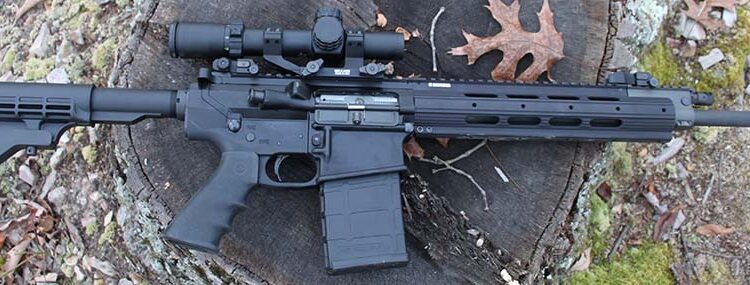By Todd Burgreen
Sturm, Ruger & Company (Ruger) has taken its concept of the AR rifle another step forward with its SR-762 .308 Win. (SR25/AR-10). The SR-762 is a short stroke gas piston AR following a similar pattern of Ruger’s SR 556 introduced previously. The Ruger SR-762 represents the latest gas-piston AR-10 pattern rifle introduced into the U.S. market. Ruger decided to enter the fray only after thoroughly exploring the topic and by designing their version of a short-stroke push rod piston driven system for the AR. One can find it indicative that the ultimate decision came down to introduce a piston-driven AR rifle versus a traditional impingement design.
Significant differences are present in the Ruger AR’s operating system compared to both the direct impingement operating system and other piston-driven operating systems. Ruger product improvements address reliability and performance issues as well as reduced carrier tilt, cam pin wear and carrier bounce. Proponents of piston-driven ARs point to greater reliability in adverse conditions and less reliance on routine maintenance compared to direct impingement operating methods. The increasing use of suppressors by civilians, law enforcement, and military highlight another advantage of the piston-driven ARs – the ability to adjust the amount of gas siphoned to operate the action. Suppressor use increases operating pressures a considerable amount and the ability to quickly turn a knob turning down the gas vented to the operating rod is a big advantage. Currently, piston driven ARs also enjoy a perception of better operating reliability in harsh environments, especially as barrel lengths shrink. Instinctually, the gas-piston AR’s appeal to many is the fact that hot gases and powder residue are not dumped into the action a la the original direct impingement (DI) design. Anecdotal evidence of bolt carriers being handled soon after long strings of fire and merely wiped down compared to their DI cousins reinforces this. Do not take this as ridicule of gas impingement ARs. The DI rifles are more robust than most give them credit for and sub-14 inch rifles are possible with attention to detail by the manufacturer in terms of gas port sizes and timing of the ejection process.
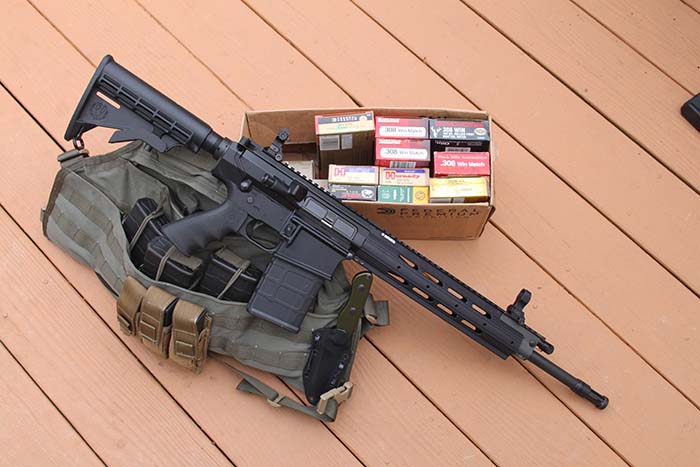
Ruger describes its short stroke piston as a two-stage affair eliminating the sharp pulse often associated with other piston ARs as the op-rod strikes the flat faced carrier key located on the bolt carrier. Ruger’s transfer rod lies behind the gas block regulator and rests between captive springs and bushings. The transfer rod is acted on by the piston between it and the gas port regulator sending it rearward to work the SR-762’s action. One interesting feature of the SR-762’s operating method is the inability to remove the transfer rod and spring for routine cleaning and maintenance. Ruger claims this is not needed as the components are nickel-Teflon coated for lubricity and rust resistance with the transfer rod spring made from stainless steel. The movement of the action provides a functional cleaning of the transfer rod. Another reason for Ruger wanting the transfer rod left alone are the bushings installed around it serve to further dampen vibration caused by the piston acting on the transfer rod. It could be problematic for the users to get these re-installed correctly after disassembly. The design makes the Ruger forend almost monolithic in design compared to free floated. Free floated forends are often temperamental in finding a load that suits it compared to “bedded” forends being steadier in accuracy across the board with a variety of loads.
Conversations with Ruger’s Mark Gurney helped to clarify what is meant by Ruger stating that their piston is a two-stage design. As stated above, Ruger wanted to minimize the sharp impulse of the piston striking the bolt carrier typically found in short-stroke ARs. This impulse is the cause of much criticism leveled at piston ARs associated with carrier tilt and the perception that piston driven ARs are inherently more inaccurate than direct impingement brethren. In laymen’s terms, the Ruger piston delivers two smaller impulses to the operating rod in lieu of one longer sharper impulse of other designs. The piston fitting inside the gas regulator is acted upon initially only by a small amount of gas once cartridge ignition occurs and moves down the barrel. The smaller nipple area of the piston moves about 3/16 of an inch unlocking the action; once this happens the larger surface area of the piston is exposed allowing gas pressure controlled by regulator to effect it and cycle the action during the second stage of piston operation. The bullet has left the barrel at this stage. In crude summary, the first stage acts to alleviate the state of inertia in the action by a “softer” impulse which is then followed by the stronger pulse working the action. The net sum of this is a less traumatic strike on the action as typified by other short stroke piston ARs leading, in theory, to better accuracy and better durability in the bolt carrier.
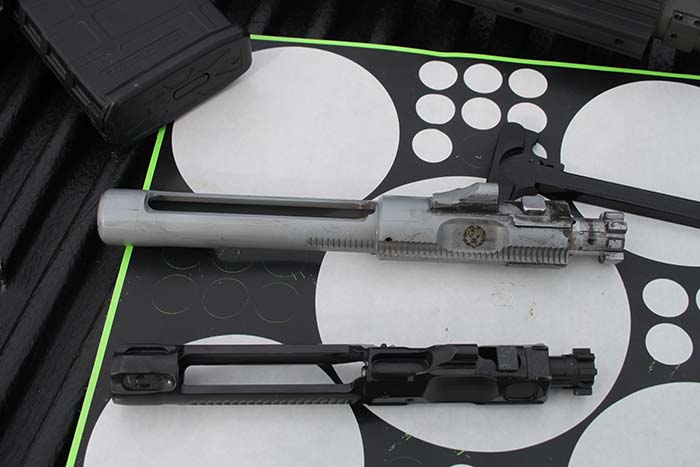
Ruger’s piston AR design has a four position gas regulator allowing for the user to completely cut gas off (Setting #0) in effect making SR-762 a manually operated rifle up to Setting #3 with the widest orifice in case the rifle is extremely fouled or underpowered ammunition encountered. Setting #2 is the normal setting. Ruger is “all in” making the SR-762 one of the most durable piston driven ARs on the market by chrome plating the piston and bolt carrier along with chrome lined Mil-Spec 41V45 1:10 twist hammer forged barrel. The SR-762 has a Ruger Mini-14 style flash suppressor mounted with a 5/8 inch-24 threads. Overall, length of the rifle is 34.75 to 38 inches depending on adjustable buttstock position. Weight of the Ruger SR-762 is 8.6 pounds.
The Ruger SR-762 features a minimized rail design and that helps to save weight. Not all weapons need rails and an array of accessories to be considered viable. While reliability should never be compromised in terms of cost/performance ratios, other items considered a must for some may not be high priority or worth it for others. The Ruger forend rail is rounded with smooth sides combined with full length flattop receiver featuring Mil-Spec 1913 Picatinny rail at the 12 o’clock position that extends the full length of the handguard. The Ruger forend is drilled and tapped for additional rails at the 3, 6, and 9 o’clock positions with two additional rail sections included with the rifle to use as owner sees fit. Three Magpul 20-round 7.62 magazines are included along with a very functional soft case for the rifle. Along these lines, Samson iron sights are also included serving as stand alone battle sights or folded down acting as back-up sights once an optic is mounted. A Mil-Spec trigger group rides in the Ruger’s lower receiver. An over engineered match or any kind of competition trigger that can malfunction or go out of adjustment is not suitable for a fighting rifle. All of the Ruger features are intended for maximizing effectiveness during a fight or realistic training on the range. The key component in a fighting rifle is reliability. No matter how accurate or powerful chambering a rifle is, if it does not work 100% of the time it is a liability. All of these features, including slim forend rail, would be several hundred dollars if a user were to purchase a base rifle and set up with these features accessed as after market accessories.
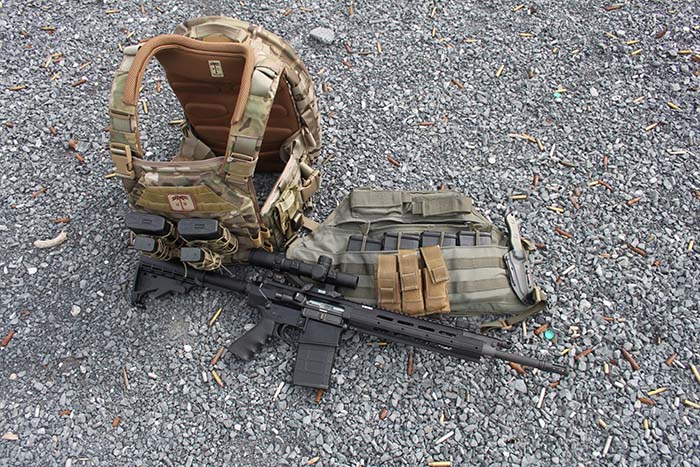
Suppressor use is increasingly popular in the civilian and military/LE realm. As a result, Ruger’s SR-762 is suppressor friendly even though suppressing a .308 AR type rifle while maintaining reliability is difficult. There is simply too much gas volume and pressure in an AR .308 type rifle to allow for proper function without some kind of gas adjustment to account for the suppressor. The need for simple adjustment at the gas block was obvious with Ruger responding. Ruger’s multi adjustable gas system accommodates this.
A Weaver Tactical 1-5x with Illuminated MDR Reticle was used along with a Leupold Mk 4 3.5-10x. The Weaver Tactical 1-5x is designed for instinctive, close-range/low-magnification situations with illuminated reticles, yet allow shooters to engage targets with greater precision at longer ranges thanks to the 5x. The Weaver Tactical 1-5x scope will strike many as unconventional in terms of commonly associated optics on a military style rifle. However, for law enforcement, civilian or private security contractor it is worthy consideration as it supplements the Ruger SR-762’s performance flexibility. The SR-762 mated to variable power Weaver optic is able to handle diverse roles albeit close range engagements or further. The concern for operating the magnified Weaver Tactical in a CQB environment is quelled once one becomes familiar with the Bindon aiming concept. Human vision is based upon a binocular (two eyes) presentation of visual evidence to the brain. The addition of a bright red or green dot in the center of the cross-hairs makes it very easy to keep both eyes open, especially at a low power setting. The brain merges the two images. During dynamic movement, the scene through the telescope blurs because the image moves more rapidly due to magnification. The one eye sees the bright dot against the blurred target scene, so the brain picks the scene from the unaided eye. The shooter swings the weapon towards the target while perceiving the dot indicating where the weapon is pointed. As soon as the weapon begins to become steady in the target area, the brain switches to the magnified view.
The Leupold Mk 4 3.5-10x scope served as primary optic during accuracy testing. Frankly, the Leupold could be left on the Ruger SR-762 if a user desired; based on the accuracy level exhibited by the rifle. An offset mount bracket featuring a Leupold Deltapoint or similar pattern red dot offered by other manufacturers would quell any concerns of the Leupold not being conducive in a CQB engagement. The offset mount allows a quick rotation of the rifle in the shoulder pocket a few degrees accessing the red dot optic with minimal effort or disturbance of handling.
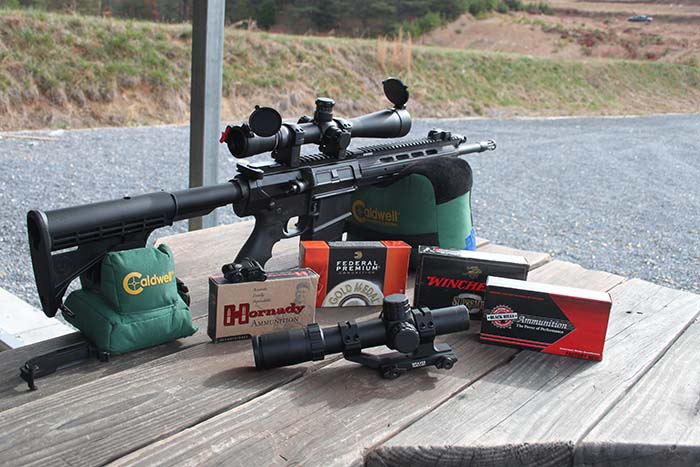
Winchester 168gr Match, Hornady 168gr TAP, Federal 168gr Match, and Black Hills Ammunition 168gr Match was used evaluating the Ruger SR-762. No ammunition tested produced over 1.75 inch groups at 100 yards with most five round groups at 1 inch or slightly over. This is quite a statement. There are many bolt action rifles chambered in .308 that do not have this type of accuracy – let alone a factory mass produced semiautomatic AR. FMJ loads from Winchester were tested as well. This was more for making sure of functionality than for primary use. The Ruger SR-762 proved reliable throughout this evaluation with over 400 assorted rounds sent downrange. The SR-762 accepts Magpul PMag 20-round magazines. Three are shipped with the rifle. Several more of the Magpul magazines were acquired for this evaluation. Magpul’s PMag 20LR magazine is quickly becoming the standard .308/7.62x51mm AR magazine with several manufacturers setting up their lowers to utilize the Magpul product. Quality magazines are a linchpin for a reliably functioning semiautomatic or select-fire weapon.
The Ruger SR-762’s 16 inch barrel combined with 168gr bullets produced velocity in the low to mid 2,500 fps range when tested over a RCBS chronograph. The SR-762 was evaluated at Echo Valley Training Center (EVTC). The rifle was not only evaluated within the 100 yard bays at EVTC firing from barricades and engaging multiple targets, but also back at the prepared firing position line with targets placed out to 300 yards. Numerous drills were run involving magazine changes and moving between barricades simulating cover. US Palm Multi Platform Attack Rack chest rig and Agile Combat System (ACS) armor was used in evaluating the Ruger SR-762. The Multi Attack Rack is a low profile platform that can be configured for a variety of magazine profiles. For this evaluation with Ruger SR-762 it was set up for five PMag magazines and four pistol magazines. The Multi Attack Rack chest rig can be worn over hard or soft body armor and is built to military specifications out of 500d Cordura nylon for durability and minimal weight. It allows for a Level III soft armor insert. The ACS also comes with a Level III soft armor insert with ability to install hard SAPI plates. Like the Ruger SR-762, the US Palm ACS is imminently adaptable allowing a user to configure front and rear components as needed based on perceived mission needs. The ACS is another addition to US Palm’s stable of products available for security conscience civilians, military, or law enforcement. The ACS mounts quickly and offers body armor protection along with capability to carry rifle magazines and pistol magazines if so configured.
Ruger’s decision to expand its AR model line-up with the piston driven SR-762 is a valid one. While the SR-762 is not going to be issued to our military services, LE and security conscience individuals would do well to consider it. The combining of the AR platform with the increased power represented in the .308/7.62x51mm cartridge is the key to its appeal. This is speaking in terms of lethality and effective range, while still allowing for multiple rounds sent quickly downrange if needed in a close range melee. In training courses experienced involving LE, military and private security contractors the mantra of “one mag one kill” is often repeated in relation to the M16/AR-15. While the 5.56mm round is often chided in terms of lethality, the .308/7.62x51mm does not suffer from this reputation. With budgets constantly under pressure, the Ruger SR-762 could be the answer to fulfilling a multitude of roles – DMR rifle, general-purpose patrol rifle, or entry weapon. This is a positive reflection on the rifle’s accuracy, reliability, handling and ergonomics.
| This article first appeared in Small Arms Review V18N2 (April 2014) |



